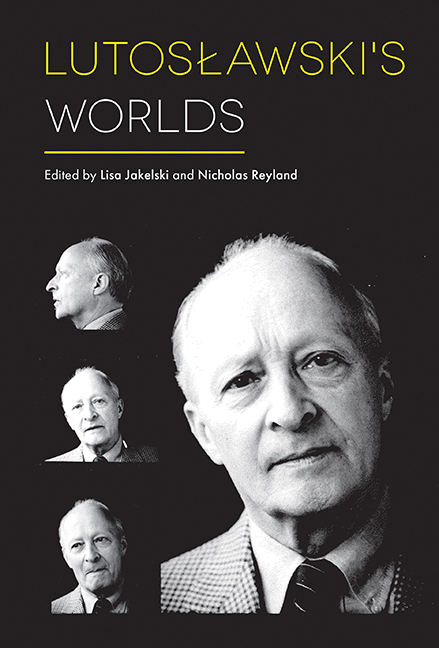Book contents
- Frontmatter
- Dedication
- Contents
- List of Figures
- List of Tables
- List of Music Examples
- List of Contributors
- Acknowledgements
- Introduction
- PART I mourning, modernism, and genius
- PART II other lutoslawskis
- 4 Behind the Curtain of Oblivion: Lutoslawski's Music for Theatre and Radio Plays
- 5 Derwid as Lutoslawski's Patron
- 6 Witold Lutoslawski in Occupied Warsaw
- 7 Lutoslawski and Sonoristics
- PART III documents
- PART IV political engagement
- PART V legacies
- Bibliography
- Index
7 - Lutoslawski and Sonoristics
from PART II - other lutoslawskis
Published online by Cambridge University Press: 14 June 2019
- Frontmatter
- Dedication
- Contents
- List of Figures
- List of Tables
- List of Music Examples
- List of Contributors
- Acknowledgements
- Introduction
- PART I mourning, modernism, and genius
- PART II other lutoslawskis
- 4 Behind the Curtain of Oblivion: Lutoslawski's Music for Theatre and Radio Plays
- 5 Derwid as Lutoslawski's Patron
- 6 Witold Lutoslawski in Occupied Warsaw
- 7 Lutoslawski and Sonoristics
- PART III documents
- PART IV political engagement
- PART V legacies
- Bibliography
- Index
Summary
The originality of Witold Lutosławski's music, and the strong sense of independence the composer manifested throughout his career, make it difficult to define his relationship to the trends, styles and techniques of his time. If we assume that Lutosławski was regarded, especially by foreign observers, as the informal leader of the formation called the ‘Polish School of the 1960s’, it seems a particularly interesting challenge to attempt to determine the potential affinities between his compositional solutions and the devices commonly used in this circle.
At the start it should be noted that the discussion of a ‘Polish School’, a controversial construct that is essentially indefinable in strictly musical terms, usually does not proceed without reference to the concepts of sonorism (sonoryzm) and/or sonoristics (sonorystyka). The first of these terms is commonly used (especially in Poland), and, because of its stylistic connotations, it is sometimes treated almost as a synonym for the ‘Polish School’. On the other hand we have the concept of sonoristics created by the Polish music theorist Józef M. Chomiński (1906–1994) during the mid- 1950s. According to Zbigniew Granat's dictionary definition, sonoristics is a ‘descriptive category for the novel sound qualities of twentieth-century music that … gained structural functions in a composition’. In contrast to the notion of sonorism, which emerged inspired by the writings of Chomiński and is usually used in combination with various qualifiers, sonorystyka is a less restrictive and more inclusive term. It designates a specific compositional technique developed by composers considered as belonging to musical modernism. Chomiński traces an evolution of this technique starting with the achievements of Debussy through the work of Stravinsky and Bartók, representatives of the Second Viennese School (especially Webern), the serial works of Boulez and Stockhausen and electronic music. Despite the fact that Witold Lutosławski declared his distance from any common contemporary musical trends, I will try to prove that the idea of sonoristics might be a useful tool in understanding certain aspects of his music – especially from the 1960s – that are marked by significant technical innovations.
Such an approach requires some substantial clarification, starting with the very definition of sonoristics. Chomiński described sonoristics as a ‘purely sonorous technique’ (technika czysto brzmieniowa), the essence of which is to treat ‘the purely sonorous values as the main means of expression and thus as a structural factor’.
- Type
- Chapter
- Information
- Lutoslawski's Worlds , pp. 165 - 182Publisher: Boydell & BrewerPrint publication year: 2018
- 2
- Cited by



